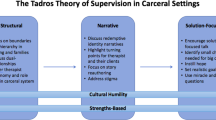Abstract
This article applies the tenets of Bernard’s in Counselor Edu Supervision 19:60–68, (1979) discrimination model of clinical supervision to the supervision needs of those who provide direct care to adolescents in residential treatment due to abuse, neglect, behavioral, or emotional problems. The article focuses on three areas (intentionality, flexibility, and professionalism) in which the model may be particularly effective in meeting the needs of youth care workers serving adolescents in residential treatment in the United States.
Similar content being viewed by others
References
American Counseling Association. (2005). ACA code of ethics. Alexandria, VA: American Counseling Association.
Anglin, J. P. (2002). Creating an extrafamilial living environment: The overall task of a group home. Child and Youth Services, 24(1–2), 79–105.
Association for Child & Youth Care Practice. (1995). Ethics of child & youth care professionals. Retrieved from http://www.acycp.org/standards/CYC%20Ethics%20Code%20Rev%209.2009.pdf.
Axford, N., Berry, V., Little, M., & Morpeth, L. (2006). Developing a common language in children’s services through research-based inter-disciplinary training. Social Work Education, 25(2), 161–176.
Barker, P. (1988). The future of residential treatment for children. In C. E. Schaefer & A. J. Swanson (Eds.), Children in residential care: Critical issues in treatment (pp. 1–16). New York: Van Nostrand Reinhold Company.
Bernard, J. M. (1979). Supervisor training: A discrimination model. Counselor Education and Supervision, 19, 60–68.
Bernard, J. M., & Goodyear, R. K. (2009). Fundamentals of clinical supervision (4th ed.). Boston, MA: Allyn & Bacon.
Berrick, J. D. (1993). Group care for children in California: Trends in the 1990’s. Child & Youth Care Forum, 22(1), 7–22.
Borders, L. D., & Brown, L. L. (2005). The new handbook of counseling supervision. Mahwah, NJ: Lawrence Erlbaum Associates.
Bradley, L., & Ladany, N. (2001). Counselor supervision. London: Taylor & Francis.
Courtney, M. E., Dolev, T., & Gilligan, R. (2009). Looking backward to see forward clearly: A cross-national perspective on residential care. In M. E. Courtney & D. Iwaniec (Eds.), Residential care of children: Comparative perspectives (pp. 191–208). New York: Oxford University Press.
Courtney, M. E., & Iwaniec, D. (2009). Residential care of children: Comparative perspectives. New York: Oxford University Press.
Curry, D., McCarragher, T., & Dellmann-Jenkins, M. (2005). Training, transfer, and turnover: Exploring the relationship among transfer of learning factors and staff retention in child welfare. Children and Youth Services Review, 27, 931–948.
Decker, J. T., Bailey, T. L., & Westergaard, N. (2002). Burnout among childcare workers. Residential Treatment for Children and Youth, 19(4), 61–77.
Fabry, B., Reitz, A., & Luster, W. (2002). Community treatment of extremely troublesome youth with dual mental health/mental retardation diagnoses: A data based case study. Education and Treatment of Children, 25(3), 339–355.
Foster, V., & McAdams, C. (1998). Supervising the child care counselor: A cognitive developmental model. Child &Youth Care Forum, 27(1), 5–19.
Garfat, T. (2004). Meaning making and intervention in child and youth care practice. Scottish Journal of Residential Child Care, 3(1), 9–16.
Garfat, T. (2009). Relational aspects of controls from within. Reclaiming Children and Youth, 17(4), 13–15.
Harrington, W. A., & Honda, G. J. (1986). The roles of the group home direct care worker. Community Mental Health Journal, 22(1), 27–38.
Hawkins, R., Meadowcroft, P., Trout, B., & Luster, W. (1985). Foster family-based treatment. Journal of Clinical Child Psychology, 14(3), 220–228.
Jones, L., Landsverk, J., & Roberts, A. (2007). A comparison of two care giving models in providing continuity of care for youth in residential care. Child &Youth Care Forum, 36, 99–109.
Kavanagh, D., Spence, S., Sturk, H., Strong, J., Wilson, J., Worrall, L., et al. (2008). Outcomes of training in supervision: Randomised controlled trial. Australian Psychologist, 43(2), 96–104.
Mattingly, M. A., Stuart, C., & VanderVen, K. (2002). North American certification project (NACP): Competencies for professional child and youth work practitioners. Retrieved from http://www.acycp.org/standards/CYCcomp10-20-2001.pdf.
Ober, A., Granello, D., & Henfield, M. (2009). A synergistic model to enhance multicultural competence in supervision. Counselor Education and Supervision, 48(3), 204–221.
Payne, W. J., Schreiber, D., & Riley, G. (2004). Transitions in counselor preparation: From occupational training programs to professional education. Journal of Teaching in the Addictions, 3(2), 19–28.
Phelan, J. (2009). Activities of daily living and controls from within. Reclaiming Child and Youth, 17(4), 46–51.
Scott, C. G. (2000). Ethical issues in addiction counseling. Rehabilitation Counseling Bulletin, 43(4), 209–214.
Sias, S., & Lambie, G. (2008). An integrative social-cognitive developmental model of supervision for substance abuse counselors-in-training. Journal of Teaching in the Addictions, 7(1), 57–74.
Teather, E. (2001). A Peek into the trenches: Changes and challenges in residential care. Residential Treatment for Children & Youth, 19(1), 1–20.
Tromski-Klingshirn, D. M., & Davis, T. E. (2007). Supervisees’ perceptions of their clinical supervision: A study of the dual role of clinical and administrative supervisor. Counselor Education and Supervision, 46(4), 294–304.
Zimmerman, D. P., & Cohler, B. J. (2000). From disciplinary control to benign milieu in children’s residential treatment. Residential Treatment for Children & Youth, 18(2), 27–54.
Author information
Authors and Affiliations
Corresponding author
Rights and permissions
About this article
Cite this article
Byrne, A.M., Sias, S.M. Conceptual Application of the Discrimination Model of Clinical Supervision for Direct Care Workers in Adolescent Residential Treatment Settings. Child Youth Care Forum 39, 201–209 (2010). https://doi.org/10.1007/s10566-010-9100-z
Published:
Issue Date:
DOI: https://doi.org/10.1007/s10566-010-9100-z




